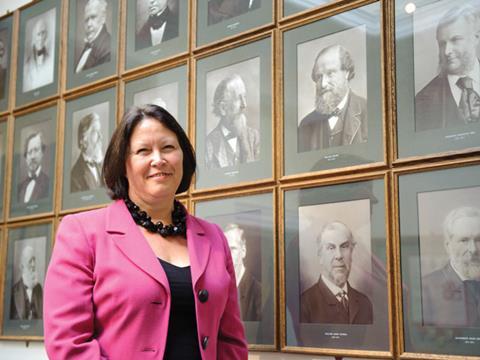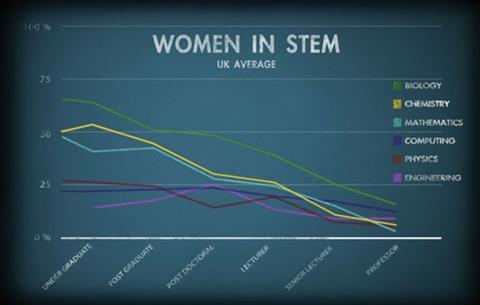While overt gender discrimination is less common today, women are still leaving chemistry in greater numbers than men. Laura Howes looks at how people are mending the leaky pipeline
On the second floor of Burlington House, the Royal Society of Chemistry’s London home, the walls are covered with photographs of past presidents of the society and its precursors. All of those faces are men. Lesley Yellowlees of the University of Edinburgh in the UK, the first female president of the RSC, describes the traditional image of chemistry as male, pale and stale – but she is certainly not male or stale. As anyone who has met Yellowlees will know, she’s a big personality: loud, colourful and not afraid to talk about difficult issues, including the gender divide in science. Not surprisingly, her election and subsequent initiatives became national news.

‘It made a big impact,’ says Yellowlees of her election. ‘But in a way it’s a shame that it was worthy of remark.’ Times have changed since women who tried to study chemistry were pelted with rubbish and laughed out of the lecture theatre. But while obvious discrimination is, in the most part, no longer socially acceptable, women are still leaving the field in higher numbers than their male counterparts. Half of UK chemistry undergraduates are female, but that share drops to 6% at the professorial level, a pattern mirrored in industry. The troubling conclusions are that implicit and unconscious biases may still be discouraging women from pursuing a scientific career. That, says Yellowlees, is a waste of scientific expertise. Changing the culture to be more supportive of women, she adds, will be better for individuals and better for the science.
A slow start
Traditionally, universities were exclusively male environments. The women who did practice chemistry had not studied in universities but were often the relations of gentleman scientists who drove the subject forward during the enlightenment. They may have attended lectures by Humphry Davy and Michael Faraday at the Royal Institution, but women were not allowed to join the scientific societies of the time.

As chemistry moved out of the home laboratory and into universities, women did not initially move with it. And when they tried, riots were liable to break out. In a letter to The Scotsman in 1873, a female student, Sophia Jex-Blake, outlined her ill treatment from a chemistry professor at the university who refused to lecture to the women. Alexander Crum Brown was, however, much admired throughout his career and his name is given to a professorship at the university. Today, Polly Arnold holds that position, one of three female professors in a department where 20% of the senior scientists are female.
‘It had not occurred to me for many years that anybody would be biased, because I assumed that scientists could not be biased,’ explains Arnold, who is clear that she wants to be a role model for her science rather than her gender. ‘As the years went by I looked around and realised I was being naïve.’ It was moving to Edinburgh that made Arnold realise that there were actually problems: ‘I was no longer one of only two women in a chemistry department,’ she explains, and that made her realise how odd her previous experiences had been. Arnold has used a recent Royal Society Rosalind Franklin award to look at the experiences of women in the chemistry department in Edinburgh and to try and see what was different. The money has been used to produce a booklet and film, called A chemical imbalance, about women’s experiences in the department and the wider issues of female representation in chemistry.
Arnold found the department has a very different culture to others. As well as having reached a critical mass of women and monitoring their numbers, she says, the department has always had a strong history of mentoring. ‘This has been happening for a hundred years,’ she adds. ‘People have been supporting each other, men and women, and when you identify someone who’s really good you make sure you encourage them to stay in the system so they don’t give up after their first failed application.’
Better for all
Some departments have been consciously addressing their gender balance for several years. When he was head of department, Robin Perutz at the University of York, UK, says that the RSC was investigating good practice in chemistry departments and noted some of the efforts that the department was making. ‘I wasn’t aware that what we were doing anything different,’ he laughs. But York was held up as an example.

One step that several universities and companies have made is to try and address the problems surrounding maternity leave and child care. Across society, expectations surrounding child care see many women leaving the workforce after having children. But a recent report published by the RSC1 showed that as women progress through their PhDs they often change their minds about pursuing a career in research. One of the issues identified by the report was that many women were discouraged by the lack of female role models who they saw as having a good balance between family life and their academic career.
At York, says Perutz, they have worked hard to introduce formal and informal flexible working to help those returning to work after parental leave. They are also careful to organise seminars and meetings at family-friendly times so as not to disadvantage parents who may have to pick children up from school. ‘Everybody [in the department] recognises that this is worthwhile and benefits everybody,’ he adds. ‘Good working practice is 100% compatible with good science. You don’t need a competitive culture in order to get somewhere.’
The University of Cambridge’s gender diversity champion, Athene Donald of the physics department, is also clear that small actions can make a difference. The UK university recently started a scheme to support carers returning to work by awarding small grants to allow a childminder or other parent to travel with them to conferences. And many conferences, including the large American Chemical Society national meetings, now offer free childcare. However, recent discussions on Donald’s blog2 suggested that for some, non-attendance is often blamed on a lack of childcare when in fact there are other reasons, such as a feeling that male-dominated conferences are just not pleasant for women to attend.
And of course, not all women have children or take the main child-caring role. In Donald’s case, her husband quit his job to take care of their children while she pursued her career. ‘I think it’s wrong to concentrate on childcare all the time, because not everybody wants that,’ adds Yellowlees. ‘It’s the supportive environment that’s needed.’
Watching the numbers game
Both York and Edinburgh’s chemistry departments have been awarded Athena Swan gold awards for their work on supporting women in their departments, although as Chemistry World went to press the results of the 2013 awards were not yet out. Awards and initiatives like Athena Swan recognise universities’ and departments’ work in promoting gender equality through a variety of methods. And in part that requires keeping track of the numbers of women at different levels of advancement.
Back when York was first highlighted by the RSC, the department was not monitoring its gender diversity. ‘But we’ve found that it’s important to keep track of numbers and be prepared to act on things that could be improved,’ explains Perutz. The numbers are important for guidance, he adds, and shouldn’t just be looked at every time an Athena Swan submission is due. For example, the York chemistry department currently sees a drop at the postdoc level, before the numbers rise again to 45% women at the lecturer level. Some of that is natural fluctuation, Perutz admits, but it is something the department is monitoring. While he notes that the numbers are perhaps too small within a department for social scientists to find useful, he would welcome more engagement with social scientists at the national level, where year-to-year fluctuations would be evened out.
Departmental monitoring of diversity and involvement with initiatives such as Athena Swan are going to become even more important for departments in the coming years. In January 2013, the UK research councils announced that equality and diversity would be taken into consideration in the 2014 Research Excellence Framework exercise, and European funding under the Horizon 2020 scheme will also consider gender diversity.
In industry there is also more pressure to improve diversity and inclusivity, to improve organisations. As Yellowlees adds, in the current economic climate, no-one can afford to waste talent just because it’s female. But both academia and industry continue to suffer from a ‘leaky pipeline’. Could it be that women are just not suited to science, or are unconscious biases harming women’s careers?
What is unsaid
A 2003 report by the US National Science Foundation3 found that women earn less, are promoted less often and publish less frequently than their male colleagues, even when controlling for factors such as age and academic rank. In the late 1990s, studies4 had begun to show that women had to be about twice as productive as their male counterparts to be as successful in securing financial support. Instead of anecdotes, this was documented proof that discrimination still existed. Perhaps the problem was not, as previously claimed, that women didn’t want to do science but that they were prevented from continuing.

The implication is not necessarily that scientists are consciously harming the job prospects of their female colleagues, but that it happens through their unconscious biases. Last year, a study5 from Yale University in the US surprised many people after it concluded that science faculty – both male and female – presented with job applications rated those associated with the name ‘John’ as significantly more competent and employable than ‘Jennifer’. The only difference between the two applications was the name at the top.
‘Those studies really did shake up the academic world in science,’ says Arnold. But, she adds, the studies were following similar findings in other subject areas. ‘I think all awareness is important,’ she says. ‘Everybody needs to be reminded of these data.’
Unfortunately, while in industry it might be possible to anonymise applications, the small size of the academic chemistry world means that it is often very clear whose CV you’re looking at, even if they are written in the same way. Instead, says Perutz, you have to realise there is an issue and try to avoid allowing unconscious biases to affect you. As well as alerting his departmental colleagues to the recent findings, Perutz says they will also be considering further action. ‘One of the things we plan is to look further at the issue and how it affects us,’ he explains.
For some, these unconscious biases can only be countered with quotas, but not everyone Chemistry World spoke to for this article is in favour of them. Certainly women who are promoted should not have to justify themselves against accusations of tokenism, and Arnold is clear that if people see that the best people are encouraged, then it’s not tokenism. No-one would promote or hire someone who couldn’t do the job, but perhaps the field can be levelled through improved mentoring and a greater awareness of bias.
What now?
Great strides have been made to get women into the scientific workplace and to improve the workplace for everyone. But the risk, according to Arnold, is that with so much having been achieved, it would be easy to say that there was nothing else to be done. ‘I’m scared that we’ll rest on our laurels,’ she says.
We should be selecting from 100% of the gene pool
Polly Arnold
Recent studies have shown that there are still hurdles that women have to overcome, but successful departments have felt the benefit of mentoring and creating a supportive environment. More still needs to be done to help fix the leaky pipeline – and some of the problems, such as wider societal perceptions and expectations, are bigger than the departments they affect. However, by continual monitoring and increased awareness, the proportion of female senior scientists should improve.
‘Change comes slowly,’ says Perutz; ‘you have to work at it, think about it and see what you can do.’ But everyone agrees that the reasons in favour outweigh the effort of continuing to support and promote women in science. ‘Problems are solved by the teams with the most diverse compositions,’ concludes Arnold. ‘We should be selecting from 100% of the gene pool for the best lecturers and scientists.’
References
1 The chemistry PhD: the impact on women’s retention, RSC, 2008 http://rsc.li/14DgUra
2 Athene Donald’s blog: http://bit.ly/16KMggl
3 Gender Differences in the Careers of Academic Scientists and Engineers, NSF, 2003 http://www.nsf.gov/statistics/nsf03322/
4 C Wennerås and A Wold, Nature, 1997, 387, 341 (DOI: 10.1038/387341a0)
5 C A Moss-Racusin et al, Proc. Natl. Acad. Sci. USA, 2012, 109, 16474 (DOI: 10.1073/pnas.1211286109)












No comments yet